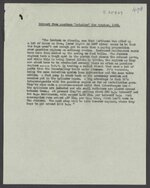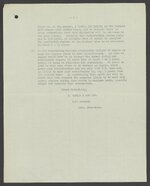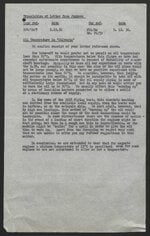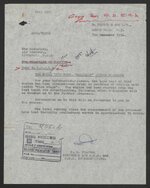Navigation
Install the app
How to install the app on iOS
Follow along with the video below to see how to install our site as a web app on your home screen.
Note: This feature may not be available in some browsers.
More options
You are using an out of date browser. It may not display this or other websites correctly.
You should upgrade or use an alternative browser.
You should upgrade or use an alternative browser.
Specifics of Jumo 205 problems?
- Thread starter Trilisser
- Start date
Ad: This forum contains affiliate links to products on Amazon and eBay. More information in Terms and rules
More options
Who Replied?brianwnz
Airman
Without looking anything up (will try and do that in coming days), generally the main problem on the 205 was the top ring & piston - it (the ring) just couldn't take the heat for long without losing tension; that then just shifted the problem down to the next ring and so on. I think many detail changes to pistons, again due to heat. I have read they could not take full power for long, without this becoming an issue. Overhaul life was quite short, based on this area I believe, although to some degree everything was back then - the 205 was notably less! Not sure if I have anything specific to the Do18, but I will see what I have. I have read the British really struggled to get one (a German 205) through their type test pre-war.
- Thread starter
- #3
The DB 605A had a TBO of 100 hours. Any figures for the Jumo 205?
Offhand I don't remember whether the 205 had pistons cooled with oil jets. Was water-injection ever tested with it? Should reduce temperatures in diesels too.
The Fairbanks-Morse opposed-piston diesels seem to have worked very well in submarines.
Offhand I don't remember whether the 205 had pistons cooled with oil jets. Was water-injection ever tested with it? Should reduce temperatures in diesels too.
The Fairbanks-Morse opposed-piston diesels seem to have worked very well in submarines.
brianwnz
Airman
Attached is an extract from from AVIA 8-436; seems to indicate 250 hours, but at 500 hours the engine was considered end-of-life - this is likely in Lufthansa service, I don't think I have a lot specific to the Do 18, but am still looking:The DB 605A had a TBO of 100 hours. Any figures for the Jumo 205?
Offhand I don't remember whether the 205 had pistons cooled with oil jets. Was water-injection ever tested with it? Should reduce temperatures in diesels too.
The Fairbanks-Morse opposed-piston diesels seem to have worked very well in submarines.
brianwnz
Airman
Some stuff so far regarding piston/ring life. These are all from AVIA 2/1934; the attached two files include a Napier letter discussing their "little difficulty" with pistons/rings, and a contemporary American article mentioning piston issues. I'll keep looking for Do 18 (or any other) specifics, but this is what I found quickly this morning. Am at work sorry, so haven't got all my notes at hand:In many books it is claimed that Jumo 205 had reliability issues in the Do 18/Bv 138. But in none of the books so far I have seen detailed descriptions (to the minutes detail) and analysis of the supposed problems. Any really detailed info on this?
Attachments
- Thread starter
- #6
brianwnz
Airman
Certainly seems that way; I think most two-stroke diesels tend to have issues in the same area sooner or later in their development, but it is apparent this was a real problem at the time for Junkers (and Napier). I will keep digging though for other issues, and especially relating to the Do 18.Very interesting info! So it seems the trouble was concentrated on one specific part.
brianwnz
Airman
Found a little bit of stuff about the Do 18; not sure if you have it already, but hopefully it is new to you. It's in German, and I've only translated part of page 8, as it related to the diesels (well, Google did the translation actually  ); looks like the unusual engine configuration in the Do 18 was not trouble-free:
); looks like the unusual engine configuration in the Do 18 was not trouble-free:



Will keep looking.....
Will keep looking.....
Attachments
brianwnz
Airman
The attached document is a small section of AVIA 8/405 dealing with the Napier Culverin, and Napier's discussions with Junkers. It gives an idea into some of the problem areas; mentions the Jumo V (later 205), and has some hours run on engines with the newer piston design (at the time). Hope it's of some interest.
Also a couple of other letters/notes from the same (large) file; one has an interesting mention of electric oil heating on the Do 18, and the other highlights the type test failure, and why, of one of the British Culverin tests.
Also a couple of other letters/notes from the same (large) file; one has an interesting mention of electric oil heating on the Do 18, and the other highlights the type test failure, and why, of one of the British Culverin tests.
Attachments
- Thread starter
- #10
Hi,The DB 605A had a TBO of 100 hours. Any figures for the Jumo 205?
The "overhaul life" of the German engines is often different in the engine maker's manuals and the RLM directives about overhaul life.
The early DB 605 versions suffered several problems that restricted the RLM defined major overhaul life to, 50, 75 or 100 hours. However, the Daimler-Benz design life was 200 hours for Grunduberholung (Full overhaul). This is a complicated subject, particularly due to the problems that the engines had. As an aside, The wartime Rolls-Royce Merlin engine life varied with types but, the design overhaul life was based on 33% of engines reaching the overhaul life before failure or being withdrawn for early overhaul with serious fault.
The Jumo 205 C2 and C3 are RLM listed with 150 hours overhaul life and the C4, D and E versions are listed with 200 hours.
Eng
- Thread starter
- #12
The DB 605A in Finnish service definitely had the TBO listed as 100 hrs and references indicate that not a single engine reached that figure during the war in Finnish service. And that with the Notleistung banned. Especially flight training killed the life of the DB. It was very fragile.
The DB 605 A/B was not fragile. However, it did suffer from specific low standard metals and development problems that caused restrictions until improvements were made. It had a relatively short overhaul life and specific weaknesses until its development was satisfactory in late 1943 standard. Even then, it was limited by the still relatively low standard metals that had to be used in manufacture and the resistance that the RLM exercised against redesigning the Bf 109 and Bf 110 aircraft to accept an improved engine oil system that Daimler-Benz wished to use.The DB 605A in Finnish service definitely had the TBO listed as 100 hrs and references indicate that not a single engine reached that figure during the war in Finnish service. And that with the Notleistung banned. Especially flight training killed the life of the DB. It was very fragile.
Yes, I know of the low overhaul lives achieved.
Eng
Please, do tell.and the resistance that the RLM exercised against redesigning the Bf 109 and Bf 110 aircraft to accept an improved engine oil system that Daimler-Benz wished to use.
The DB 605 A/B/C had vulnerabilities in its engine oil system from the start. Like the Merlin, these problems were reduced by several modifications and updates as Daimler-Benz got to understand them. Calum Douglas covers some of this in his book, The Secret Horsepower Race. Major changes of the oil system that required changes to the airframes that used the engines were repeatedly delayed to prevent disruption of aircraft production. Details of these specifics should appear in due course.Please, do tell.
Eng
Thank you, I'm aware of the problems with oil system on the DB engines being an designed shortcoming.
What I'm mostly interested in is about the bolded part of the sentence quoted in this post:
What I'm mostly interested in is about the bolded part of the sentence quoted in this post:
Major changes of the oil system that required changes to the airframes that used the engines were repeatedly delayed to prevent disruption of aircraft production.
Users who are viewing this thread
Total: 1 (members: 0, guests: 1)
Similar threads
- Replies
- 0
- Views
- 537
- Replies
- 15
- Views
- 2K




